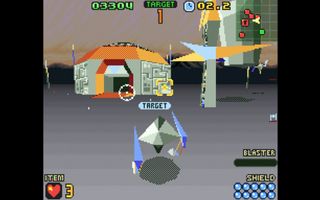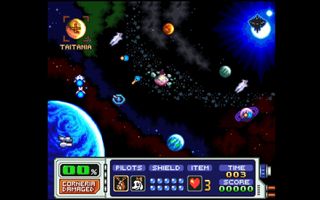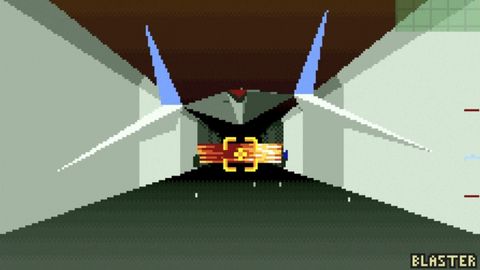If nothing else, Star Fox 2 – now finally released on the SNES Mini, after languishing somewhere on a Nintendo hard-drive for 22 years – is a fantastic insight into where the company’s head was at on the eve of the 32 and 64-bit 3D gaming explosion. Developed with partner studio Argonaut, the polygon-pushing Super FX chip’s long-delayed last hurrah is a package typified by a grandiose, free-wheeling ambition not seen in any of the SNES games the technology previously powered.
The effect is unmistakable from the moment you fire the game up. Even viewed through the lens of two decades’ subsequent advancement, the flat-shaded sci-fi extravaganza is a surprisingly cinematic production, its cutscenes – both introductory and punctuating progress throughout the game – ambitious and arresting on a level previously never seen on the format. Even as a sequel to the game that first asked ‘How can this be done on a SNES?’ Star Fox 2 bellows the query louder than ever.

And if Star Fox 2’s presentation typifies an aggressively confident Nintendo, riding a creative high at the peak of the SNES’ industry-dominating success, then its game design, in an entirely different, initially jarring way, is a similar declaration of uninhibited intent. Albeit one that doesn’t always succeed in its admirable ambitions.
Because Star Fox 2 is not the sequel you expected, whether you were waiting for it in 1995 or not. Jettisoning the first game’s concept without sentiment, Star Fox 2 drops its precursor’s branching campaign of linear arcade shooting, and plays out its journey on a single map. This map is where you’ll spend half of every playthrough – and Star Fox 2 is indeed a game built for multiple playthroughs, its conceit not dogged campaign completion, but repeat, iterative plays for better results. Star Fox 2, you see, isn’t far off Star Fox XCOM.
You’ll will fly through space and negotiate ground-based attacks, shooting through a plethora of enemy craft as you go. But you’ll also (loosely) plan your strikes, navigating the map in a constant balance of aggression, defence, and resource management. If this sounds like an early sketch for the later, tactics-based DS game Star Fox Command, that’s because it absolutely is. The inspiration for that game is suddenly very clear, looking back into Nintendo’s cancelled plans for 1995. Though I will point out that the “sketch” part of that sentence is important.

You won’t ever play on Corneria. The series’ iconic homeworld and frequent starting stage is now resigned to the role of defence objective. At one end of the map is Andross, safely holed up behind Planet Venom. At the other, your precious blue base-world. In between is a collection of enemy battleships, planet-bound missile bases, and featured space-battles, the latter of which spawn at designated points during your run. Your objective, as a two-ship team of wingmen, is to steadily erode the enemy forces in the system on your way to confronting the beardy-ape big-bad, while taking detours to mitigate incoming missile damage to Corneria and maintain your own team’s chances of survival.
While the initial head-spin quickly wears off once you accept that this isn’t Star Fox as usual, the new systems will continue to confound, at least on your first playthrough. Don’t expect that first attempt to be a success. Even if you beat Andross, you’ll likely do so with a pretty poor final grade. But that’s the point. Multiple criteria feed into your ultimate score, from time taken, to Cornerian damage averted, to wingmen lost. There are only two lose-states – 100% damage to your homeworld, and the loss of both your pilots - but to really feel like you’ve won, you’ll have to manage a lot of different factors beyond shooting.
You’ll likely miss some of these the first time through, or at least fail to understand how to correctly optimise your play. There are many variables at hand in Star Fox 2, and while eventually making for a brave and impressive early evolution of the series’ format, not all are clear enough in their explanation, or robust enough in their execution, to translate into an entirely satisfying version of the game’s core idea. When you gain a full understanding of how Star Fox 2 works, you’ll suddenly enjoy it a lot more, despite its ongoing flaws, but it may take a while to get to that point. Again, this perhaps is the point, but that point’s delivery can be a tad rough, and slightly lacking in user-friendliness. There’s simply a hell of a lot to take in when you first get going, and you’ll primarily learn through surprise failure.

For starters, you now have six members of the Star Fox team to choose from before you begin, with ‘newcomers’ Miyu and Fay rounding out the crew. And there are a whole bunch of different load-out archetypes between the team – from low health, high speed, to all-rounders, to the multiple different support abilities on display, which cover everything from shields, to manual health regeneration, to bombs.
Putting together a strong, complimentary two-ship team is evidently intended to be a fundamental part of the experimentation path, though in practice, your choices are rarely game-changers. Prioritise taking down potential missile strikes as you travel between big enemy targets, and take trips back to the Great Fox mothership to repair – once docked, you can warp around the map, making back any time lost on the trip - and pretty much any team can do the job. There is a fair degree of fun to be had in mixing up your play-style through, and exploiting particular special abilities in certain key encounters.
As for those practical encounters, there’s a disappointing slightness to the actual combat half of Star Fox 2. The missile takedowns that typify the first half of a playthrough are a simple case of tracking a target through space, catching up with it using your ship’s boost, and then shooting it a few times before returning to the map screen. Some interception missions mix things up by throwing multiple targets into the mix, but the process is never any more complicated. Use a fast character for these sections, and they’re over in under a minute. Sometimes a matter of seconds.

And when dogfights crop up, during the appearance of a Star Wolf fighter or an Andross-invoked alien threat, it’s largely the same again, albeit with a tad more challenge. Track, boost, shoot, repeat. With enemy behaviour both repetitive and predictable, this sections are more attritional than exciting. Remember to – yes – do a barrel roll when your opponent attacks, and any incoming damage will be negligible. It’s also worth noting that all space-based combat in Star Fox 2 takes place via the abstraction of a first-person cockpit cam, a la the first game’s Asteroid Belt, which does rather reduce the feeling of connection to the action.
Things get much more interesting when you hit planet-based sections of the game, but again, don’t expect any real hark back to the original game’s action. Here, simple free-roaming environments are smattered with enemies and key targets, such as shield generators to shoot down, or switches to activate in order to access a main base interior.
Although simple, and somewhat chuggy to handle, these sequences do however deliver some of the most intriguing and progressive insights into Nintendo’s mid-‘90s 3D evolution. The fact that you’re exploring free-roaming 3D in a SNES game, for all of the technical clunkiness, never ceases to impress on a conceptual level. And with your Arwing able to transform into a bipedal walker tank upon a quick stab of the Select button, the sense of playing a game before its time (even now, 20 years after its time) takes on a giddy new palpability.

As your campaign progresses, and missile strikes and battleships become a thing of the past (on Normal difficuly at least; Hard will screw with you relentlessly), gameplay will escalate to take in simple maze navigation within nonlinear enemy bases, in which more key targets must be found and dealt with, before moving on to boss fights. Again, it’s all very impressive on a conceptual level, but the simplicity with which everything is (probably necessarily) executed continues to make Star Fox 2 feel like an exciting curio rather than a vital gameplay experience in its own right. You will want to take up that offer of replays though. The scoring criteria – which only really reveal themselves at the end of a run – are stern but logical, enticing you do one better the next time, with the certainty that if you just tighten up your early game, you surely can. And Hard mode introduces some more interesting locations and enemies, as well as brutal new strategic demands.
It’s easy to see reasons why Star Fox 2 might not have been released as originally planned, aside from Nintendo's entirely plausible claims that the next generation of N64-powered 3D was just too close to justify another Super FX-powered outing. Back in 1995, the design concept may have been too radical, its ideas too experimental, to avoid confounding fans - at least as the first sequel in a burgeoning franchise. And while many of the ideas in play are certainly excellent, you can indeed feel the SNES creaking while trying to do them justice on the scale they deserve.
But today? When bundled ‘free’ with the already great SNES Mini? Star Fox 2 is a very welcome addition. You might not love it as much as you want to, or indeed in the way that you want to. But as a time-warp into a long-lost, and terribly important, part of Nintendo history, it’s as invaluable as it is intriguing.


